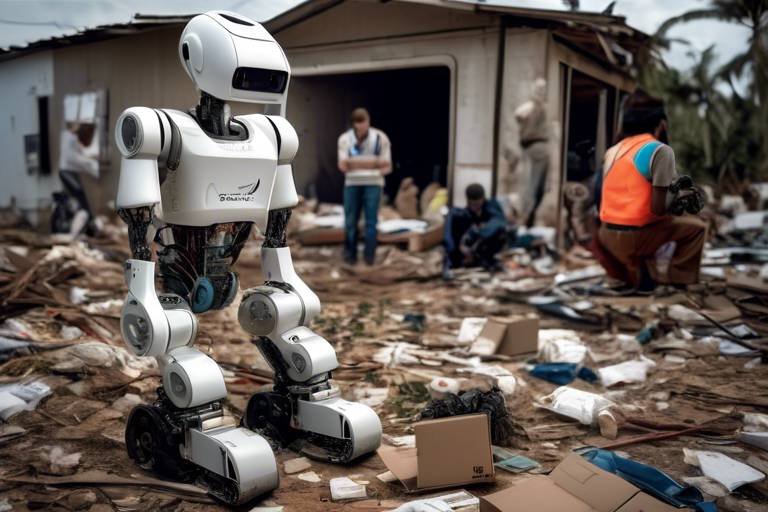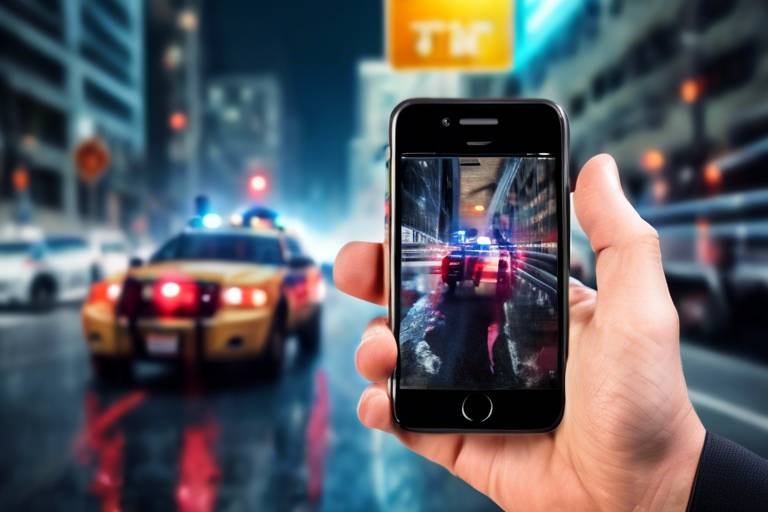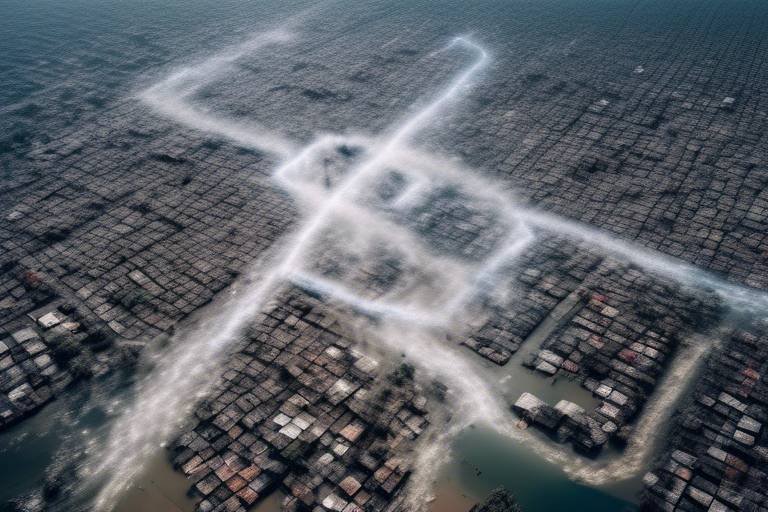The Role of Robotics in Disaster Relief
Robotics technology is revolutionizing the way we approach disaster relief, making a significant impact on efficiency, safety, and effectiveness in emergency response. Imagine a world where robots can navigate treacherous terrains, locate survivors trapped under debris, and deliver essential supplies—all while human responders focus on high-stakes decision-making and care. This is not just a futuristic dream; it is happening right now. As we delve deeper into the role of robotics in disaster relief, we will uncover how these machines are not only enhancing our capabilities but also redefining the very nature of humanitarian response.
In recent years, we've witnessed a surge in the integration of robotics into various aspects of disaster management. From search and rescue missions to logistical support, the applications of robotics are diverse and impactful. For instance, drones can quickly survey disaster zones, while ground robots can transport supplies to hard-to-reach areas. These innovations are crucial in reducing response times and ultimately saving lives. The importance of robotics in disaster relief cannot be overstated; they act as force multipliers, allowing human teams to operate more effectively and safely in chaotic environments.
Furthermore, the use of robotics is not just about immediate response; it also plays a vital role in recovery efforts. Robots can assist in assessing damage, clearing debris, and even providing temporary shelter solutions. This multifaceted approach ensures that the recovery process is not only faster but also more organized. With the ability to collect and analyze data in real-time, robotics provides responders with invaluable insights that aid in planning and resource allocation. In essence, robotics is transforming disaster relief from a reactive process into a proactive, strategic operation.
- What types of robots are commonly used in disaster relief?
Common types include drones for aerial surveillance, ground robots for logistics, and underwater robots for marine rescues. Each serves a unique purpose in enhancing disaster response efforts.
- How do drones improve search and rescue operations?
Drones equipped with thermal imaging can detect heat signatures, allowing responders to locate trapped individuals quickly and efficiently.
- What are the main challenges in using robotics for disaster relief?
Challenges include technical limitations in extreme conditions, high costs of advanced technology, and the need for specialized training for personnel.
- What does the future hold for robotics in disaster response?
Advancements in AI and machine learning are expected to enhance robotic capabilities, leading to more effective and autonomous systems in the field.

Introduction to Robotics in Disaster Relief
In the face of natural disasters and emergencies, the speed and efficiency of response can mean the difference between life and death. Robotics technology is emerging as a game-changer in disaster management, bringing innovative solutions that enhance search and rescue operations, logistics, and recovery efforts. Imagine a world where drones soar above debris-laden landscapes, pinpointing survivors with pinpoint accuracy, while ground robots navigate treacherous terrains to deliver essential supplies. This is not science fiction; it's the reality of modern disaster relief.
Robotics in disaster relief isn't just about flashy gadgets; it's about real-world applications that save lives and streamline operations. By employing unmanned systems, first responders can access areas that are too dangerous or difficult for humans to reach. This technology allows for a more comprehensive understanding of the situation on the ground, ultimately leading to improved decision-making and resource allocation. Furthermore, the integration of robotics can significantly reduce the physical and emotional toll on human responders, enabling them to focus on what they do best—helping those in need.
To truly grasp the impact of robotics in disaster relief, consider the following key areas where these technologies shine:
- Search and Rescue: Robots can perform tasks that are hazardous for humans, such as searching collapsed buildings or navigating through hazardous environments.
- Logistics and Supply Chain: Ground robots can transport food, water, and medical supplies to those in need, ensuring timely aid delivery.
- Data Collection: Drones equipped with advanced imaging technologies gather critical information about disaster zones, facilitating better planning and response strategies.
As we delve deeper into the various types of robots employed in emergencies, it becomes clear that their roles are diverse and indispensable. The future of disaster response is not just about human effort; it's about leveraging technology to enhance our capabilities. In an era where every second counts, robotics stands at the forefront of revolutionizing how we respond to crises.

Types of Robots Used in Emergencies
In the chaotic aftermath of disasters, the role of robotics becomes a beacon of hope. Various types of robots are deployed to tackle the unique challenges posed by emergencies. These machines, equipped with cutting-edge technology, are not just tools; they are lifelines that enhance the efficiency and effectiveness of disaster response efforts. From the skies above to the ground below, different types of robots serve distinct purposes, each contributing to the overarching goal of saving lives and facilitating recovery.
One of the most prominent categories of robots used in emergencies is drones. These aerial marvels are equipped with advanced imaging technology, allowing them to survey disaster zones from above. They can quickly locate survivors, assess damage, and provide real-time data to rescue teams. Imagine a bird's-eye view of a devastated area, where every second counts, and drones swoop in to gather critical information that could mean the difference between life and death.
Another essential type of robot is the ground robot. These machines are designed to navigate through debris and hazardous environments, transporting supplies and equipment where human responders might struggle. Picture a rugged, all-terrain vehicle tirelessly working to deliver food, water, and medical supplies to those in need. Their ability to traverse challenging landscapes not only reduces the risk to human responders but also ensures that aid reaches affected individuals promptly.
For situations involving water rescues, underwater robots come into play. These specialized machines are designed to operate in marine environments, assisting in search and rescue operations where traditional methods may fall short. They can explore submerged areas, locate victims, and even gather vital data for recovery efforts. Think of them as the underwater heroes, bravely venturing into the depths to bring back those in distress.
To summarize, the types of robots used in emergencies can be categorized as follows:
| Type of Robot | Functionality |
|---|---|
| Drones | Aerial surveillance, damage assessment, locating survivors |
| Ground Robots | Transporting supplies, navigating debris, assisting responders |
| Underwater Robots | Search and rescue in marine environments, data collection |
As we delve deeper into the capabilities of these robots, it's essential to recognize that each type plays a crucial role in the overall disaster response strategy. Their integration into emergency services not only enhances operational efficiency but also amplifies the safety of human responders. The future of disaster relief is undoubtedly bright, with robotics leading the charge toward more effective and humane responses to crises.

Search and Rescue Drones
In the chaotic aftermath of a disaster, every second counts, and that's where come into play. These remarkable machines are equipped with cutting-edge technology that enables them to perform crucial tasks that can save lives. Imagine a scenario where a building has collapsed due to an earthquake. Traditional search methods can be time-consuming and dangerous, but drones can swiftly survey the area from above, providing real-time data and imagery to first responders. This aerial perspective is invaluable, allowing rescue teams to prioritize their efforts and locate survivors more efficiently.
One of the standout features of these drones is their advanced imaging technology. Equipped with high-resolution cameras and sensors, they can capture detailed images of disaster zones, helping responders assess the extent of damage and identify areas that require immediate attention. But it doesn’t stop there; many drones also come with thermal imaging capabilities. This technology allows them to detect heat signatures, making it easier to locate individuals trapped under debris. In situations where every moment is critical, the ability to pinpoint survivors hidden from view can make all the difference.
Moreover, search and rescue drones are not just about locating survivors; they play a significant role in mapping and surveillance. By creating real-time maps of affected areas, these drones provide essential information that helps in resource allocation and planning. For instance, the data gathered can inform rescue teams about the safest and most efficient routes to take, ensuring that aid reaches those in need without unnecessary delays. This capability is particularly crucial in large-scale disasters where the landscape can change dramatically, and traditional maps may no longer be accurate.
To illustrate the impact of search and rescue drones, consider the following table that highlights their key features and benefits:
| Feature | Benefit |
|---|---|
| Advanced Imaging | Provides clear visuals of disaster zones for better assessment |
| Thermal Imaging | Detects heat signatures to locate trapped individuals |
| Real-Time Mapping | Creates updated maps for efficient resource allocation |
| Rapid Deployment | Can be deployed quickly to assess situations in hard-to-reach areas |
In summary, search and rescue drones are revolutionizing the way we respond to disasters. Their ability to quickly gather and relay crucial information not only enhances the safety of rescue operations but also significantly increases the chances of saving lives. As technology continues to advance, we can expect even greater improvements in the capabilities of these drones, making them an indispensable tool in disaster relief efforts.
- What types of drones are used in search and rescue operations?
Various types of drones are utilized, including fixed-wing drones for long-distance flights and quadcopters for hovering and maneuverability in tight spaces.
- How do drones improve the efficiency of rescue missions?
Drones can cover large areas quickly, provide real-time data, and access hard-to-reach locations, allowing rescue teams to focus their efforts where they are needed most.
- Are there any limitations to using drones in disaster scenarios?
Yes, drones can be affected by weather conditions, and their battery life limits the duration of their operations. Additionally, technical training is required for operators.

Thermal Imaging Technology
Thermal imaging technology is a game-changer in the realm of disaster relief, particularly when it comes to search and rescue operations. Imagine being in a situation where every second counts, and you need to locate survivors trapped under debris. This is where thermal imaging steps in like a superhero, allowing drones to detect heat signatures even in the most chaotic environments.
How does it work? Essentially, thermal cameras capture the infrared radiation emitted by objects, which means they can visualize heat rather than light. This capability is crucial in disaster scenarios, where traditional visual methods may fail due to darkness, smoke, or obstructed views. When a drone equipped with thermal imaging flies over a disaster zone, it can quickly identify hotspots—areas where heat is being emitted, such as a trapped person or even animals in distress.
The effectiveness of thermal imaging technology can be summarized in a few key points:
- Rapid Detection: Drones can cover large areas quickly, significantly speeding up the search process.
- Enhanced Visibility: Works in low-light conditions, making it invaluable during nighttime operations.
- Life-Saving Precision: Increases the chances of finding survivors, allowing rescue teams to focus their efforts where they are most needed.
Moreover, the integration of thermal imaging with advanced data analytics is paving the way for even more sophisticated rescue operations. By analyzing heat patterns, responders can not only locate individuals but also assess the overall situation in real-time. This information can inform strategic decisions, such as where to deploy resources or which areas require immediate attention.
As we look to the future, the potential for thermal imaging technology in disaster relief continues to expand. With advancements in machine learning and AI, we can expect drones to become even more adept at interpreting thermal data, leading to faster and more effective rescue missions. In essence, thermal imaging is not just a tool; it’s a lifeline in the race against time during disasters.
- What is thermal imaging technology? Thermal imaging technology detects heat emitted by objects, allowing for visualization of temperature differences in a given area.
- How does thermal imaging benefit disaster relief? It enables rapid identification of heat signatures, aiding in the location of trapped individuals, especially in low-visibility situations.
- Can thermal imaging work in adverse weather conditions? While it is effective in many scenarios, heavy rain or fog can sometimes limit its effectiveness.
- Are drones with thermal imaging expensive? Yes, they can be costly, but the investment is often justified by the potential lives saved during emergencies.

Mapping and Surveillance
In the chaotic aftermath of a disaster, having accurate and timely information is crucial for effective response and recovery efforts. This is where technology comes into play, particularly through the use of drones. These aerial marvels are not just toys; they are powerful tools that can transform the way we understand a disaster zone. Imagine being able to see a bird's-eye view of a devastated area, pinpointing where help is needed most, all within minutes of the event. This capability is not just advantageous; it is essential.
Drones equipped with high-resolution cameras and advanced sensors can quickly generate real-time maps that provide critical insights into the extent of damage. These maps can highlight areas that are inaccessible to ground teams, enabling responders to focus their efforts where they are needed the most. For instance, after an earthquake, drones can fly over the affected region and create detailed topographical maps that reveal collapsed buildings, blocked roads, and other hazards. This information is invaluable for planning rescue operations and allocating resources efficiently.
Moreover, the integration of geospatial data enhances the effectiveness of disaster management strategies. By overlaying satellite imagery with drone-captured data, responders can track changes over time, assess the impact of their interventions, and adapt their strategies accordingly. This dynamic approach ensures that resources are not wasted and that every decision is informed by the latest information available.
Additionally, the use of drones for mapping and surveillance can significantly reduce the risks associated with human-operated reconnaissance missions. In situations where the environment is unstable or dangerous, sending a drone can be far safer than deploying personnel. This not only protects human lives but also allows for quicker assessments, which can lead to faster response times. In essence, drones serve as the eyes in the sky, guiding ground teams to where they are needed most.
While the advantages of drone mapping and surveillance are clear, it is essential to consider the regulatory and operational challenges that can accompany their use. Issues such as airspace restrictions, privacy concerns, and the need for skilled operators must be addressed to fully harness the potential of this technology. However, as regulations evolve and technology advances, the future of drone-assisted mapping in disaster relief looks promising.
- What types of drones are used for mapping in disaster relief?
Drones equipped with high-resolution cameras, thermal imaging, and LiDAR sensors are commonly used for mapping disaster zones. - How do drones improve response times in emergencies?
Drones can quickly survey large areas, providing real-time data that helps responders make informed decisions faster than traditional methods. - Are there any risks associated with using drones in disaster scenarios?
Yes, challenges include regulatory issues, the need for skilled operators, and potential privacy concerns that must be managed.

Ground Robots for Logistics
In the chaotic aftermath of a disaster, every second counts, and ground robots are stepping up to the plate to ensure that vital supplies reach those in need as quickly as possible. These remarkable machines are designed to navigate through challenging terrains, including debris-strewn streets and flooded areas, where human responders may find it difficult or even dangerous to operate. Imagine a world where robots can transport food, water, and medical supplies, effectively becoming the lifeline for affected communities. This is not just a dream; it’s happening now!
Ground robots are equipped with advanced navigation systems and sensors that allow them to assess their surroundings in real-time. They can identify obstacles, avoid hazards, and even communicate with other robots or human operators to coordinate logistics. This level of autonomy is crucial in disaster scenarios, where the environment can change rapidly and unpredictably. For instance, a ground robot can be deployed to deliver essential supplies to a remote area, while simultaneously relaying information about the conditions it encounters back to the command center.
One of the standout features of these robots is their versatility. They can be customized for various tasks, making them invaluable in disaster relief operations. Here are a few key functions they can perform:
- Supply Transportation: Ground robots can carry heavy loads, such as food and medical supplies, ensuring that aid reaches those who need it most.
- Debris Clearance: Some robots are designed to clear pathways, making it safer for human responders to enter hazardous areas.
- Communication Hubs: Equipped with communication tools, these robots can establish networks in areas where infrastructure is down, facilitating better coordination among rescue teams.
Moreover, the deployment of ground robots not only enhances the efficiency of logistics but also significantly reduces the risk to human lives. By taking on the more dangerous tasks, these robots allow human responders to focus on what they do best: providing care and support to those affected by disasters. In many cases, they can work alongside human teams, complementing their efforts and ensuring a seamless response.
However, it's important to recognize that while ground robots are powerful tools, they are not a panacea. Their effectiveness is often contingent upon proper training and integration within existing disaster response frameworks. As technology continues to advance, the potential for these robots to revolutionize logistics in disaster relief becomes increasingly apparent. The future is bright, and with continued investment in robotics, we can expect to see even more innovative solutions that will save lives and streamline recovery efforts.
- What types of ground robots are used in disaster relief? There are several types, including autonomous delivery robots, debris-clearing robots, and communication relay robots, each serving specific functions in disaster scenarios.
- How do ground robots navigate in challenging environments? Ground robots use a combination of sensors, cameras, and advanced algorithms to detect obstacles and navigate through difficult terrains safely.
- Can ground robots operate in extreme weather conditions? While many ground robots are designed to withstand harsh conditions, their performance can be affected by severe weather, which is a challenge that developers continue to address.
- How are ground robots controlled during disaster response? Ground robots can be operated remotely by human operators or can function autonomously, depending on their design and the specific mission requirements.

Challenges in Implementing Robotics
As we delve into the fascinating world of robotics in disaster relief, it’s crucial to acknowledge the challenges that accompany this technological revolution. While the potential benefits are enormous, the path to effective implementation is riddled with obstacles that must be addressed. One of the primary challenges is the technical limitations that robots face in extreme conditions. For instance, when a disaster strikes, the environment can be chaotic, filled with debris, and often hazardous. Robots may struggle to navigate through rubble or operate effectively in adverse weather conditions. This limitation can hinder their ability to perform crucial tasks, such as locating survivors or delivering supplies.
Moreover, the cost of advanced robotics technology can be a significant barrier for many organizations involved in disaster relief. High-end drones and ground robots come with a hefty price tag, which may not be feasible for smaller NGOs or local agencies. This financial strain can limit the accessibility of these life-saving tools, leaving some areas without the necessary resources to respond effectively to disasters. Exploring funding options, such as grants or partnerships with tech companies, can be vital in overcoming these financial hurdles.
Another challenge lies in the need for trained personnel. Even the most sophisticated robots are only as effective as the operators behind them. There is a growing need for individuals who are not only skilled in robotics but also understand the unique challenges of disaster response. Training programs must be developed to equip responders with the necessary skills to operate these machines efficiently. Without proper training, the potential of robotics in disaster relief may remain untapped.
To illustrate these challenges further, consider the following table that summarizes the key obstacles in implementing robotics for disaster relief:
| Challenge | Description |
|---|---|
| Technical Limitations | Robots may struggle to function in extreme environments, affecting their operational efficiency. |
| Cost | High costs can limit accessibility for smaller organizations and hinder widespread adoption. |
| Need for Training | Effective operation of robots requires skilled personnel, necessitating comprehensive training programs. |
In summary, while the integration of robotics into disaster relief offers incredible potential, it is essential to address these challenges proactively. By overcoming technical limitations, ensuring financial accessibility, and investing in training, we can unlock the full power of robotics to save lives and aid recovery in times of crisis.
- What types of robots are commonly used in disaster relief?
Drones for aerial surveillance, ground robots for logistics, and underwater robots for marine rescues are commonly used in disaster scenarios. - How do drones improve disaster response?
Drones enhance situational awareness by providing real-time data, mapping disaster areas, and locating survivors quickly. - What are the main challenges faced when implementing robotics?
Key challenges include technical limitations, high costs, and the need for trained personnel. - How can organizations overcome the cost barrier for robotics?
Exploring grants, partnerships, and innovative funding solutions can help organizations access necessary technology.

Technical Limitations
While robotics has revolutionized disaster relief efforts, it's not without its . These challenges can significantly impact the effectiveness of robotic systems in real-world scenarios. One of the most pressing issues is the robots' ability to function in extreme conditions. For instance, when navigating through debris or unstable environments, many robots struggle to maintain stability and mobility. Picture a robot trying to cross a field of rubble; it may get stuck or topple over, rendering it useless in a critical moment.
Moreover, the weather can pose a significant challenge. High winds, heavy rain, or extreme temperatures can impair a robot's sensors and communication systems. For example, drones may have difficulty flying in strong winds, while ground robots may face traction issues on slippery surfaces. These environmental factors can limit the operational range and reliability of robotic systems.
Another critical limitation is the battery life of robotic devices. Many robots are powered by batteries that may not last long enough to complete a mission, especially in prolonged disaster scenarios. Imagine a drone that can only fly for 30 minutes before needing a recharge; this time constraint could mean missing out on crucial opportunities to gather data or locate survivors.
Furthermore, the integration of robotics into existing disaster response frameworks can be challenging. Many first responders are not adequately trained to operate these advanced technologies, leading to inefficiencies. The need for specialized training can slow down the deployment of robotic systems, which is counterproductive in emergencies where every second counts. Addressing these is essential for enhancing the capabilities of robots in disaster relief.
In summary, while robotics offers promising solutions for disaster relief, understanding and overcoming these technical limitations is crucial. The future of robotics in this field will depend on continuous innovation and the development of more resilient, adaptable systems that can withstand the unpredictable nature of disaster scenarios.
- What types of robots are most commonly used in disaster relief?
Common types include drones for aerial surveillance, ground robots for logistics and debris removal, and underwater robots for marine rescues.
- How do drones assist in disaster relief?
Drones equipped with thermal imaging can locate survivors and create real-time maps of disaster areas, providing essential data for responders.
- What are the main challenges of using robotics in disaster response?
Challenges include technical limitations, high costs, and the need for trained personnel to operate these advanced systems.
- What advancements can we expect in the future of robotics for disaster response?
Future advancements may include improved AI and machine learning capabilities, leading to more effective and autonomous robotic systems.

Cost and Accessibility
The integration of robotics in disaster relief is a game-changer, but it doesn't come without its hurdles, particularly in terms of cost and accessibility. The advanced technology that powers these robots, from drones to ground units, often carries a hefty price tag. For many organizations, especially non-profits and smaller emergency services, the financial burden can be overwhelming. Imagine needing a cutting-edge drone for a rescue mission but finding out that the budget can't stretch that far. It's a frustrating scenario that highlights the disparity in resources available to different agencies.
Furthermore, the cost isn't just about the initial purchase. Maintenance, training personnel, and ensuring the technology remains up-to-date also add to the overall expenditure. Many organizations find themselves caught in a cycle where they want to adopt these technologies but can't justify the ongoing costs. This leads to a crucial question: How can we make robotics more accessible to those who need it most?
One potential solution lies in exploring funding options. Government grants, private donations, and partnerships with tech companies can provide the necessary financial support to help organizations acquire and maintain robotic systems. For instance, some tech companies have started initiatives to donate equipment or provide subsidized pricing for relief organizations. Collaboration can be a powerful tool in overcoming financial barriers.
Additionally, creating a community of practice where organizations can share resources, training, and experiences can significantly enhance accessibility. This approach not only reduces costs but also fosters innovation through shared knowledge. By pooling resources, smaller organizations can access advanced technologies that would otherwise be out of reach.
In summary, while the cost of robotics in disaster relief can be a significant barrier, exploring funding opportunities and fostering collaboration among organizations can pave the way for more equitable access to these life-saving technologies. The goal should be to ensure that every organization, regardless of size or budget, can leverage robotics to enhance their disaster response capabilities.
- What are the main benefits of using robotics in disaster relief? Robotics enhance efficiency, improve safety for responders, and allow for quicker data collection and resource allocation.
- How can organizations afford robotic technology? Organizations can explore government grants, partnerships with tech companies, and community resource sharing to alleviate costs.
- What types of robots are most commonly used in disaster scenarios? Drones for aerial surveillance, ground robots for logistics, and underwater robots for marine rescues are among the most commonly utilized.
- What challenges do robots face in disaster situations? Robots can struggle with technical limitations in extreme conditions, high costs, and the need for trained personnel to operate them.

The Future of Robotics in Disaster Response
The future of robotics in disaster response is not just promising; it’s downright exciting! As technology continues to evolve, we are witnessing a transformation that could redefine how we respond to emergencies. Imagine a world where robots, powered by artificial intelligence (AI) and machine learning, work alongside human responders to save lives and restore communities in the wake of disasters. This partnership could lead to unprecedented efficiency and effectiveness in disaster management.
One of the most significant advancements on the horizon is the development of autonomous robots. These machines will be capable of making real-time decisions based on the data they collect, allowing them to navigate complex environments without constant human oversight. For instance, a drone equipped with AI could identify the safest routes for delivering supplies, avoiding obstacles and hazards in real-time. This level of autonomy would not only speed up response times but also reduce the risks faced by human responders.
Moreover, the integration of internet of things (IoT) technology into robotics will enhance communication between devices. Imagine a scenario where drones, ground robots, and even wearable technology used by responders all communicate seamlessly. This interconnectedness would create a comprehensive network, allowing for better coordination and resource allocation during emergencies. As a result, responders would have access to real-time data from multiple sources, enhancing situational awareness and decision-making.
Another exciting development is the potential for collaborative robots, or cobots, which can work alongside humans in disaster zones. These robots can assist with heavy lifting, debris removal, or even providing medical supplies to those in need. By taking on physically demanding tasks, cobots can help prevent injuries among human responders, allowing them to focus on strategic planning and direct assistance to victims.
Furthermore, advancements in robotic materials and design will make these machines more durable and adaptable to extreme conditions. For example, robots that can withstand high temperatures, heavy winds, or even flooding will be essential in various disaster scenarios. As researchers continue to innovate, we may see robots capable of operating in underwater environments or navigating through toxic debris, broadening their applicability in emergency situations.
To give you a clearer picture of the potential advancements, take a look at the table below, which outlines some of the expected innovations in robotics for disaster response:
| Innovation | Description |
|---|---|
| Autonomous Navigation | Robots that can make real-time decisions and navigate without human intervention. |
| IoT Integration | Devices that communicate with each other to enhance situational awareness. |
| Collaborative Robots (Cobots) | Robots that assist human responders with heavy lifting and logistics. |
| Durable Materials | Robots designed to withstand extreme environmental conditions. |
As we look to the future, it’s clear that the role of robotics in disaster response will continue to expand. However, it’s essential to consider the ethical implications and ensure that these technologies are used responsibly. Balancing innovation with human oversight will be crucial in maintaining public trust and ensuring that technology serves humanity in times of crisis.
In conclusion, the future of robotics in disaster response is bright, filled with opportunities to save lives and enhance recovery efforts. As we embrace these advancements, we must remain vigilant in our commitment to ethical practices, ensuring that technology complements human efforts rather than replacing them. Together, we can build a safer and more resilient world, ready to face whatever challenges may arise.
- What types of robots are used in disaster response? Various types of robots are employed, including drones for aerial surveys, ground robots for logistics, and underwater robots for marine rescues.
- How does AI enhance the capabilities of disaster response robots? AI allows robots to make real-time decisions, improving their ability to navigate complex environments and respond effectively to changing situations.
- What are the main challenges in implementing robotics in disaster relief? Key challenges include technical limitations, high costs, and the need for trained personnel to operate these advanced technologies.
Frequently Asked Questions
- What types of robots are commonly used in disaster relief?
In disaster relief, various types of robots play crucial roles. Drones are often utilized for aerial surveillance, while ground robots help with logistics and debris removal. Additionally, underwater robots are deployed for marine rescues, each serving specific purposes that enhance overall efficiency in emergency response.
- How do drones assist in search and rescue operations?
Drones equipped with advanced imaging technology can quickly survey disaster zones, locate survivors, and assess damage. Their ability to fly over difficult terrains allows for rapid data collection, which is essential for situational awareness, helping responders make informed decisions in critical moments.
- What is thermal imaging technology, and why is it important?
Thermal imaging technology enables drones to detect heat signatures, making it easier to find trapped individuals in rubble. This capability significantly increases the chances of successful rescues, especially in situations where visibility is poor, and time is of the essence.
- What challenges do robotics face in disaster response?
Despite their advantages, robotics in disaster relief encounter several challenges. Technical limitations, such as navigating extreme conditions, can hinder their effectiveness. Additionally, the high costs associated with advanced robotics can limit accessibility for many organizations, making funding and partnerships vital for implementation.
- How can advancements in AI improve robotics in disaster relief?
Advancements in artificial intelligence and machine learning promise to enhance the capabilities of robots in disaster response. These technologies can lead to more effective and autonomous systems that can adapt to rapidly changing environments, ultimately improving rescue efforts and resource management.



















